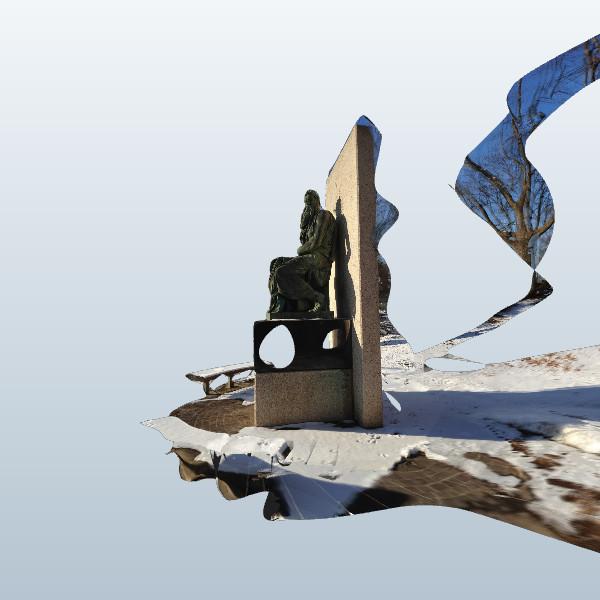Results 1 to 7 of 7
-
01-21-2015, 09:40 AM #1
Legal Implications for Sioux Falls Maker After Scanning a Michelangelo Statue
Jerry Fisher encountered some interesting pushback after photographing and making 3D models of Michelangelo’s David and Moses statues which are displayed outside at and near Augustana College in Sioux Falls, South Dakota. After being asked to remove them due to alleged copyright laws, Fisher went on a legal quest of sorts, trying to assess what the real laws are regarding something like outdoor statues, photogrammetry, and taking the process to the next level with 3D scans. In the end he received word from nonprofit organization Public Knowledge that there is a loophole regarding works that are in the public domain like the statues made by Michelangelo, and that most likely the college had no business asking Jerry to take down his 3D models. Check out more details on this interesting case in the full article: http://3dprint.com/38631/michelangelo-copyright-models/
Below is a photo of Fisher's model of Michelangelo's Moses:

-
01-21-2015, 09:45 AM #2Engineer

- Join Date
- Oct 2014
- Posts
- 441
By them even trying to get him to take it down, I bet 100 more people went and took pictures.
-
01-21-2015, 03:06 PM #3Staff Engineer

- Join Date
- Jan 2014
- Location
- Oakland, CA
- Posts
- 935
It's hard to believe that these statues are really protected by copyright. The only legal theory I can think of would be that a new copyright is brought into being when the stone originals (clearly in the public domain) were molded and cast in bronze. That seems like a stretch, but museums often try to assert a copyright on their photographs of ancient artifacts (which themselves are in the public domain), so I suppose it's possible to claim the same rights for castings. But my guess is that if they really tried to bring a case against the person who scanned them, any reasonable judge would throw it out.
Andrew Werby
Juxtamorph.com
-
01-21-2015, 05:48 PM #4Student

- Join Date
- Jan 2015
- Posts
- 3
Hello Everyone,
I am that guy who's rocking the boat metaphorically speaking.
Part of my rationale that makes me feel that I'm in the right to 3D model the Michelangelo bronzes here in Sioux Falls was the common sense fact that all of Michelangelo's body of work is in the public domain. I had hesitated over concerns about using the bronzes themselves since some might feel that they are copyrightable as they are made in a different material by a foundry that accessed state-owned plaster casts molded directly from the marble originals.
With some help from the 3D community, a legal scholar pointed me to two court cases in his blog:
http://dearrichblog.blogspot.com.au/...aelangelo.html
The following two links are from that blog and seem to be very relevant to this situation:
http://scholar.google.com/scholar_ca...=1&oi=scholarr
http://scholar.google.com/scholar_ca...=2006&as_vis=1
The gist of both rulings was that art in the public domain can't be copyrighted, even when they are transformed into a new format, material or size. The only way a reproduction could be copyrighted is if it is substantially different from the original. I guess the devil is in the details as anyone could have a field day debating what "substantially different" is.
In the second case, the judge ruled that simply reproducing something at a different scale from the original item, in a different material with a few trivial changes in the appearance was not enough to qualify for a new copyright.
On that basis, I think the precise bronze casts of Michelangelo's sculptures still fall in the sphere of public domain. As Augustana College and the City of Sioux Falls jointly own both casts, if they really want to stop 3D modeling of those particular sculptures, their only real recourse would be to remove them from outdoor public display and install them inside a space where photography is expressly forbidden. It would be a drastic and unfortunate thing if they did decide to do that or try to actively discourage hobbyists like myself.
I have come to the conclusion that 3D modeling is a fairly new concept here and neither Augustana nor Sioux Falls really know how to approach it and they preferred to err on the conservative side until the future.
I did share these links with Augustana and Sioux Falls but I don't know if they were read or considered.
I really hope that this minor fracas makes more people, both hobbyists and in governments and institutions, begin a dialogue so legitimate 3D modeling can flourish.
Jerry FisherLast edited by jerry7171; 01-21-2015 at 05:51 PM. Reason: Added a third link
-
01-22-2015, 12:09 AM #5Student

- Join Date
- Jan 2015
- Posts
- 3
The formal ownership of the Michelangelo's David is listed as Republic of Florence but is in dispute. I would say that only the Republic of Florence who currently has conservator-ship of the statue has right to request a copyright violation.
The formal ownership of the Michelangelo's Moses is the Roman Catholic Church. I would say that only the Roman Catholic Church who currently has conservator-ship of the statue has right to request a copyright violation.
No one but the current conservator of the original work of art has right to request a copyright violation.
Being gifted a replica by a conservator of work of art copyright does not transfer rights of copyright.
If these were derivative works of the original work of art then copyright could be claimed.
Not in this case both original work of art are public domain with conservator-ship held by the current owner.
Augustana College has no standing to claim copyright on these replica's.
-
01-22-2015, 11:04 AM #6Student

- Join Date
- Jan 2015
- Posts
- 3
And therein is another rub, which I would love to see addressed. While I'm using precise reproductions (albeit in a different material than the originals) and the two court rulings have clearly stated that they don't qualify for any kind of copyright protection here in the States, what is to stop other countries from stating something different and demanding compensation or deletion of the 3D models?
I can think of two recent instances where heritage things that had been in the public domain had their respective conservators/caretakers assert a fresh copyright and threatened anyone who took photographs or tried to profit from them: the Eiffel Tower in Paris, which had a new diamond sparkler lighting system mounted to it and Zahi Hawass claiming all images, designs and any derivatives from Ancient Egypt were copyrighted by the nation of Egypt. In both cases though, through some legal sleigh of hand, the claims of copyright were either rendered partially null and void or simply ignored as being an attempt to milk/bilk attention.
I personally think that taking something in the public domain and suddenly claiming it is copyrighted by whoever cares or owns it is flimsy at best, but it is the nature of the beast when institutions and organizations are facing increasingly tighter budgets and less government support.
I wish I had a simple answer to all of this, but I'm far from being a legal scholar or having the wisdom to suggest something that would work to the benefit of everyone.
Jerry Fisher
-
01-22-2015, 02:30 PM #7Staff Engineer

- Join Date
- Jan 2014
- Location
- Oakland, CA
- Posts
- 935
The cases cited above (Bridgeman v Corel and Snyder v Batlin) would tend to support your right to reproduce these statues in any form you wished, since there were no original elements added in the course of making the cast reproductions, or those elements were so minor as not to matter. In the one case cited that goes against you (concerning a scaled-down version of Rodin's "Hands of God") the court found that the differences between the original and the reproduction were substantial enough to merit copyright protection. So to be safe, you'd need to study the original marble sculptures and the castings to determine what if any difference there was between them. But to the casual eye there doesn't seem to be much difference - the bronze translation was "slavish" copying, not a new interpretation of the subject, so I think you would prevail if an action was brought against you. But going through a legal battle can be a long and expensive process, so you have to think about that before getting into it with a well-funded adversary. On the other hand, assertions of copyright on items that have long been in the public domain are annoying, and deprive the public of rights we should be able to enjoy, so I'm all for you challenging them. Here's a paper with some more discussion of the issue: http://papers.ssrn.com/sol3/papers.c...act_id=1542070
Both the US and Italy are signatories of the Berne Convention on copyrights, so they both subscribe to the same basic idea of how copyright is supposed to work. I doubt you have to fear being sued in Italy for violating their copyright laws, since they aren't that much different from ours. Conservatorship is different from copyright ownership; just because you own a piece of art doesn't give you the right to enforce a copyright on it, although you can prevent people from photographing, molding or scanning it. If the piece is sited outdoors, though, and people have been freely photographing it for many years, the assertion of a right to suppress a photo-derived scan seems problematical.
The other issue you bring up, the suppression of reproductions of public domain artifacts based on new theories of "cultural patrimony", is more difficult to deal with. This hasn't been done much in the US, although some Indian tribes have been looking into it. I haven't heard of any actual cases where people have been prosecuted or sued for reproducing ancient artifacts normally thought of as being in the public domain, but some laws recently enacted around the world make it likely that someone will do it sooner or later (although I don't think the Egyptians actually did pass that law copyrighting the pyramids). I tried to research the current state of this new body of law, but didn't find much; here's some discussion on the matter from the EU: http://www.communia-project.eu/wg03-istanbul The New Zealanders have also been wrestling with these theories, although I'm not sure if any legislation enforces them there: http://papers.ssrn.com/sol3/papers.c...act_id=1806809
Andrew Werby
Juxtamorph.com






 Reply With Quote
Reply With Quote




Extruder not feeding during print,...
Yesterday, 01:59 AM in Tips, Tricks and Tech Help